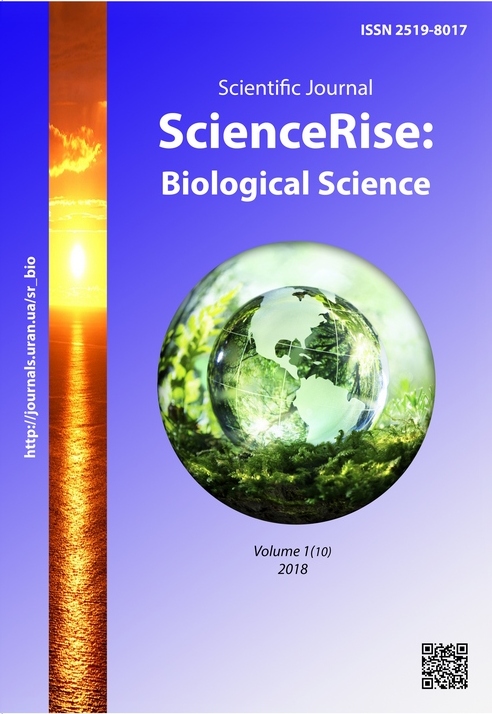Changes of macro- and microelement composition of the liver in rats for artificial hypobiosis
DOI:
https://doi.org/10.15587/2519-8025.2018.124869Keywords:
hypobiosis, hypothermia, hypercapnia, hypoxia, heart, macroelements, microelements, ferrum, potassium, sodiumAbstract
Surgeons throughout the world face numerous urgent questions as to alternative ways of anesthesia that don’t need to switch on apparatuses: “artificial heart”, “artificial lungs ventilation” at short-term surgical interventions. One of such ways can be just artificial hypobiosis. The main conditions for transferring to this stage are: hypoxia, hypercapnia, hypothermia. For using this method in surgical practice at short-term surgical interventions successfully in future, it is necessary to study a series of urgent questions, connected with its safety more detail. White usual male-rats with the mass 180–200 g, kept in standard vivarium conditions, were used in the study. The animals were divided in groups: control (intact animals) and experimental artificial hypobiosis state. The number of animals in each group n = 8. The experiments were conducted, according to requirements of the “European convention about protection of vertebral animals, used with experimental and other scientific purposes” (Strasburg, France, 1985), according to general ethic principles of experiments on animals, accepted by the First national congress of bioethics of Ukraine (2001). As a result of the conducted studies there was demonstrated the essential increase of Potassium, Sodium and Ferrum, at the same time the Calcium content decrease. The growth of Potassium and Sodium in the organism can be explained by the delay of liquid in the organism, because flowability of liquids in the organism decreases at artificially-created hypobiotic conditions
References
- Nelson, D. L., Cox, M. M. (2008). Lehninger Principles of Biochemistry. New York: W. H. Freeman, 1100.
- Storey, K. B. (2002). Life in the slow lane: molecular mechanisms of estivation. Comparative Biochemistry and Physiology Part A: Molecular & Integrative Physiology, 133 (3), 733–754. doi: 10.1016/s1095-6433(02)00206-4
- Zhenyin, T., Zhaoyang, Z., Cheng, C. L. (2011). 5′-Adenosine monophosphate induced hypothermia reduces early stage myocardial ischemia/reperfusion injury in a mouse model. American Journal of Translational Research, 3 (4), 351–361.
- Wilz, M., Heldmaier, G. (2000). Comparison of hibernation, estivation and daily torpor in the edible dormouse, Glis glis. Journal of Comparative Physiology B: Biochemical, Systemic, and Environmental Physiology, 170 (7), 511–521. doi: 10.1007/s003600000129
- Alukhin, Yu. S., Ivanov, K. P. (1998). A model of winter hibernation in a non-mammalian mammal upon cooling its brain to 1–4 °C. Adapt. organism to nature. and eco-sots. environmental conditions. Magadan, 6–7.
- Vykhovanets, V. I., Melnychuk, S. D. (2008). History of the development of models of artificial suppression of living organisms. Scientific herald of NAU, 127, 65–68.
- Kalabukhov, N. I. (1985). Hibernation of mammals. Moscow: Science, 168.
- Melnichuk, S. D., Vakhovets, V. I. (2005). The Influence of the Conditions of the Artificial Hypobiosis on the Energy Exchange in Rats. Ukrainian Biochemical Journal, 77 (3), 131–135.
- Melnichuk, S. D., Melnychuk, D. O. (2007). Animal hypobiosis (molecular mechanisms and practical values for agriculture and medicine). Kyiv: Publishing Center of NAU, 220.
- Melnichuk, D. O., Melnichuk, S. D., Arnauta, O. V. (2004). Influence of the carbon dioxide medium on the preservation of erythrocytes in the canned blood of animals. Scientific Herald NAU, 75, 163–165.
- Melnichuk, S. D. (2001). Basic indicators of acid-base blood and metabolic processes in the case of hypobiosis and general anesthesia for amputation of the limb. Ukrainian Biochemical Journal, 73 (6), 80–83.
- Melnichuk, S. D., Rogovsky, S. P., Melnychuk, D. O. (1995). Features of acid-base equilibrium and nitrogen exchange in the body of rats under conditions of artificial gipobiosis. Ukrainian Biochemical Journal, 67 (4), 67–75.
- Melnichuk, S. D., Vychanets, V. I. (2005). The Influence of Conditions of Artificial Hypobiosis on Energy Exchange in Rats. Ukrainian Biochemical Journal, 11 (3), 131–135.
- Severina, E. S. (Ed.) (2004). Biochemistry. Moscow: GEOTAR-MED,784.
Downloads
Published
How to Cite
Issue
Section
License
Copyright (c) 2018 Anna Umanska, Dmytro Melnichuk, Lilia Kalachnyuk

This work is licensed under a Creative Commons Attribution 4.0 International License.
Our journal abides by the Creative Commons CC BY copyright rights and permissions for open access journals.
Authors, who are published in this journal, agree to the following conditions:
1. The authors reserve the right to authorship of the work and pass the first publication right of this work to the journal under the terms of a Creative Commons CC BY, which allows others to freely distribute the published research with the obligatory reference to the authors of the original work and the first publication of the work in this journal.
2. The authors have the right to conclude separate supplement agreements that relate to non-exclusive work distribution in the form in which it has been published by the journal (for example, to upload the work to the online storage of the journal or publish it as part of a monograph), provided that the reference to the first publication of the work in this journal is included.









